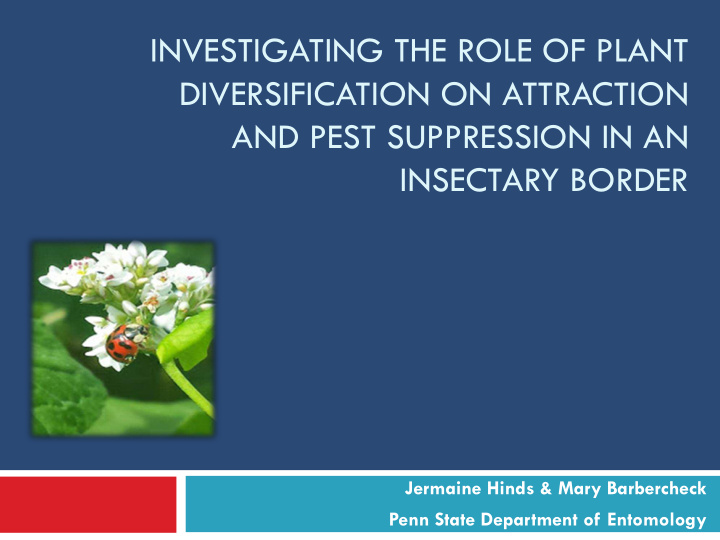



INVESTIGATING THE ROLE OF PLANT DIVERSIFICATION ON ATTRACTION AND PEST SUPPRESSION IN AN INSECTARY BORDER Jermaine Hinds & Mary Barbercheck Penn State Department of Entomology
Natural Enemies
Resource Plant Provisioning Insectary plants provision natural enemies (Lundgren, 2009). Natural enemies prefer specific resource plants (Hogg et al. 2011). Insectary mixtures may support more natural enemies.
Research Question Can plant-based resources promote natural enemy abundance? Can a mixture provide further support? Objectives: Evaluate potential of two plant species to support natural enemies by assessing: Resource availability Natural enemy abundance Predation levels Natural enemy abundance greater in presence of plant-based resources
Buckwheat Cowpea Biculture (Fagopyrum esculenum) (Vigna unguiculata) Sampling: Resource abundance Sweep net samples Sentinel eggs ( Ostrinia nubilalis )
Stand Establishment Vigorous buckwheat growth; anthesis 3 weeks after planting Poor cowpea establishment Buckwheat dominated biculture
Buckwheat inflorescences increase and cowpea EFNs decrease in biculture Number of Number of Buckwheat Inflorescences Cowpea EFNs 12 12 BW BI CP BI Average # Inflorescences per Plant * * 10 10 * Average # EFN per Plant 8 8 * * 6 6 4 4 2 2 0 0 3 4 5 3 4 5 Weeks After Planting Weeks After Planting
Total Arthropods 300 250 Total Arthropods 200 150 100 50 0 Anthocoridae Miridae Coccinellidae Thomisidae Aphididae Cicadellidae Miridae Parasitica Chrysomelidae Anthocoridae 300 Coleomegilla maculata 250 Total Arthropods 200 150 100 50 Orius spp. 0 Anthocoridae Miridae Coccinellidae Thomisidae Aphididae
Coleomegilla maculata increases with increasing number of inflorescences but not EFNs 12 BW CP BI Mean C. mac Found per 5 Sweeps * P <0.0001 10 * P =0.0001 8 6 * P <0.017 4 * P =0.057 * P <0.0001 2 * P =0.0011 0 3 4 5 Weeks After Planting
Orius spp. abundance greater in presence of flowers 12 BW CP BI Mean # of Orius Found per 5 Sweeps 10 8 ns 6 * P=0.0001 4 * P=0.0001 2 0 3 4 5 Week After Planting
Egg predation is not affected by treatment 1 0.9 0.8 0.7 Proportion of Eggs 0.6 0.5 0.4 0.3 0.2 0.1 0 BW CP BI Corn Insectary Strip Treatment
Preliminary Findings Can plant-based resources promote natural enemy abundance in insectary strips? C. maculata and Orius spp. greater in floral plots Natural enemies not abundant in cowpea Can a mixture further support natural enemies? Biculture dominated by buckwheat Does insectary strip enhance predation? Not affected by treatment
Lingering Questions and Future Directions Future Directions Are insectary strips reducing predation on arthropod prey by distracting C. maculata and Orius spp. ? How does insectary plants influence predation within nearby crops? Can management of insectary plants be used to “push” beneficial insects into nearby cash crops?
Acknowledgements USDA NIFA-OREI Program Cover Crop Cocktails Group NE-SARE Graduate Student Grant Bunton-Waller Fellowship Alfred P. Sloan Foundation Lloyd. E. Adams Memorial Award International Association of Black Entomologists Russell E. Larson Ag Research Center Staff
Recommend
More recommend